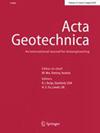A breakage-based discrete element study of stress relaxation in quartz sands
Abstract
Stress relaxation of quartz sands is simulated using a recently proposed physically based time-to-fracture discrete element method framework. The framework incorporates time-dependency through stress-corrosion-induced grain fracture. This feature is embedded into a pre-existing particle-splitting-based rough-contact crushable model. The model is calibrated to represent Fontainebleau sand, a quartz sand. A controlled on–off computational strategy is adopted to advance the simulation efficiently. Model predictions are shown to compare favourably with laboratory results in oedometric and triaxial conditions in terms of stress relaxation and relaxation rate. Grain size distribution evolution is also tracked and shown to compare well with available laboratory results. The influence of initial mobilized strength q/qmax on stress relaxation is recovered by the model, and explained through increased grain breakage. The simulated relaxation results are examined at the microscale and compared with those from creep experiments. The model displays the nonisochronous behaviour characteristic of sands. The relaxation tests display a state shift towards higher dilatancy conditions that may offer a possible explanation for some observations of pile set-up.

 求助内容:
求助内容: 应助结果提醒方式:
应助结果提醒方式:


